
The Pinwheel Galaxy is a face-on spiral galaxy 21 million light-years away from Earth in the constellation Ursa Major. It was discovered by Pierre Méchain in 1781 and was communicated that year to Charles Messier, who verified its position for inclusion in the Messier Catalogue as one of its final entries.

Messier 108 is a barred spiral galaxy about 28 million light-years away from Earth in the northern constellation Ursa Major. It was discovered by Pierre Méchain in 1781 or 1782. From the Earth, this galaxy is seen almost edge-on.
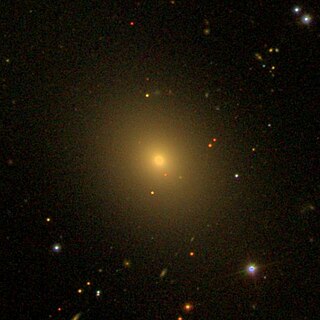
NGC 57 is an elliptical galaxy in the constellation Pisces. It was discovered on 8 October 1784 by astronomer William Herschel.

NGC 474 is an elliptical galaxy about 100 million light years distant in the constellation Pisces. This large galaxy is known to possess tidal shells and tidal tails, although their origins remain unclear. One possible explanation is that NGC 474 interacted with a galaxy several billion years ago.

NGC 182 is a spiral galaxy with a ring structure, located in the constellation Pisces. It was discovered on December 25, 1790 by William Herschel.

NGC 198 is a spiral galaxy located in the constellation Pisces. It was discovered on December 25, 1790 by William Herschel.

NGC 200 is a spiral galaxy located in the constellation Pisces. It was discovered on December 25, 1790 by William Herschel.
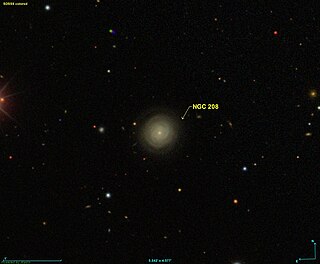
NGC 208 is a spiral galaxy located approximately 229 million light-years from the Solar System in the constellation Pisces. It was discovered on October 5, 1863 by Albert Marth.

NGC 234 is a spiral galaxy located in the constellation Pisces. It was discovered on October 14, 1784 by William Herschel.

NGC 266 is a massive barred spiral galaxy in the constellation Pisces. NGC 266 is located at a distance of 197 megalight-years from the Milky Way. It was discovered on September 12, 1784, by William Herschel. The form of this barred galaxy is described by its morphological classification of SB(rs)ab, which indicates a quasi-ring-like structure (rs) and moderate-to-tightly wound spiral arms (ab). It is the dominant member of a small group with six low-mass galaxies.
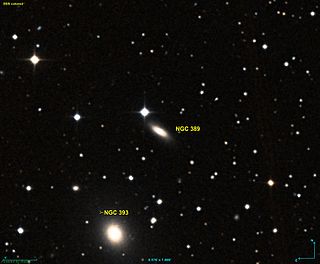
NGC 389 is a lenticular galaxy located approximately 239 million light-years from the Solar System in the constellation Andromeda. It was discovered on September 6, 1885 by Lewis Swift. It was described by Dreyer as "extremely faint, extremely small, round, star near."

NGC 5917 is a spiral galaxy located in the constellation of Libra. It was discovered by John Herschel on 16 July 1835.

NGC 523, also known as Arp 158, from the ARP catalog is a spiral galaxy located in the constellation Andromeda. It was discovered separately by William Herschel on 13 September 1784, and by Heinrich d'Arrest on 13 August 1862. d'Arrest's discovery was listed as NGC 523, while Herschel's was listed as NGC 537; the two are one and the same. John Dreyer noted in the New General Catalogue that NGC 523 is a double nebula.
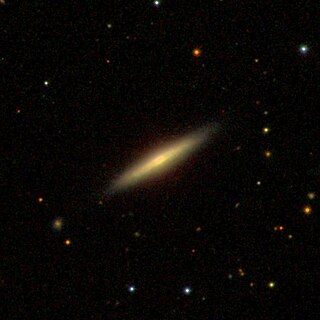
NGC 489 is probably an edge-on spiral galaxy located about 97 million Light-years away from Earth in the constellation Pisces. NGC 489's calculated velocity is 2507 km/s. NGC 489 was discovered by German astronomer Heinrich Louis d'Arrest on December 22, 1862.
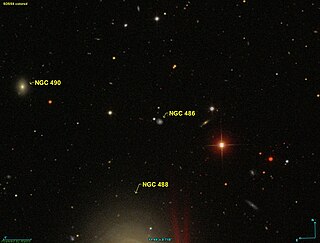
NGC 486, also occasionally referred to as LEDA 1281966 or GC 275, is a spiral galaxy in the constellation Pisces. NGC 486 was discovered on December 6, 1850 by Irish engineer Bindon Blood Stoney.

NGC 495, also occasionally referred to as PGC 5037, UGC 920 or GC 278, is a barred spiral galaxy in the constellation Pisces. It is located approximately 184 million light-years from the Solar System and was discovered on 12 September 1784 by astronomer William Herschel.

NGC 522, also occasionally referred to as PGC 5218 or UGC 970, is a spiral galaxy located approximately 122 million light-years from the Solar System in the constellation Pisces. It was discovered on 25 September 1862 by astronomer Heinrich Louis d'Arrest.

NGC 536 is a barred spiral galaxy located in the constellation Andromeda. It is located at a distance of circa 200 million light-years from Earth, which, given its apparent dimensions, means that NGC 536 is about 180,000 light years across. It was discovered by William Herschel on September 13, 1784. It is a member of Hickson Compact Group 10, which also includes the galaxies NGC 529, NGC 531, and NGC 542. It belongs to the Perseus–Pisces Supercluster.

NGC 706 is a spiral galaxy located in the Pisces constellation about 230 million light years from the Milky Way. It was discovered by the German–British astronomer William Herschel in 1786.

NGC 606 is a barred spiral galaxy located in the Pisces constellation about 470 million light-years from the Milky Way. It was discovered by the French astronomer Édouard Stephan in 1881.




















